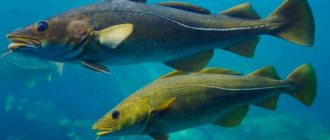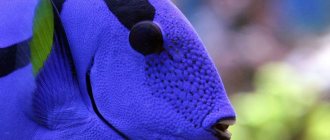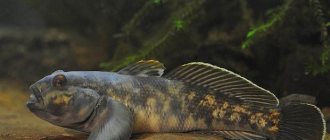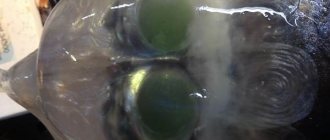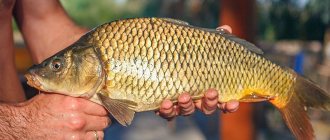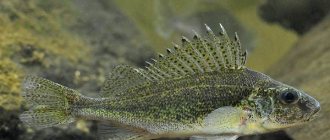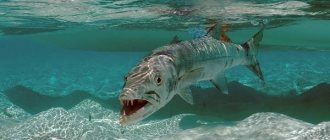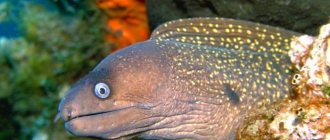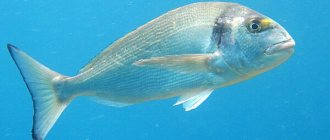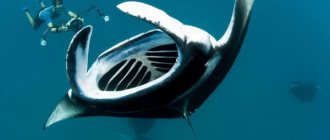Judging by the photo, the angel fish is beautiful, like a real celestial being.
But getting to know this representative of the perciforme order can surprise you, since in reality the ray-finned fish is much more beautiful.
Its large body has a clear trapezoidal shape and incredibly bright colors, which makes exotics popular.
Connoisseurs of underwater fauna are trying to get beauties to decorate tropical aquariums.
Types and their description
The average size of these inhabitants of coral reefs is 20-30 cm, some grow up to 60 cm, the smallest species do not exceed 12-15 cm.
Today, science knows about 85 subspecies of angelfish.
Representatives of the family Pomacanthidae have a characteristic body shape, similar to a rectangle. This visual impression arises from the shortened caudal fin and large, high forehead of the fish.
Royal
A bright and elegant fish that grows up to 25 cm. The royal angel fish has a fancy coloring of contrasting white-blue, dark blue and orange stripes. The tail, pelvic and pectoral fins are yellow, the dorsal end is deep blue, the anal is decorated with a honey-blue striped pattern.
Sinekoltsovy
The fish has a dark copper shade of scales with an interesting pattern in the form of bright blue stripes. This species is considered particularly graceful and is often found in species aquariums, but requires very large volumes.
Imperial
An interesting fish with a dominant turquoise color and horizontal stripes of a contrasting yellow hue. The large beige-fawn head has a dark mask. The dorsal and caudal fins are yellow, the anal fin is orange with neon edging. The imperial angel can grow up to 40 cm.
Angel of Cortez
The young are jet black with yellow and blue stripes. With age, the base color changes to a yellowish olive with thin blue lines and dark specks.
Red Stripe
A miniature species, growing no more than 15 cm in length. The fish has a silver-gray color and is decorated with bright blood-red or orange transverse lines. The dark blue tail and anal fin are outlined with a blue neon line. Paired fins, lips and eye contour are marked in soft orange. This variety requires a good mature aquarium with an established ecosystem containing a large number of underwater plants and small invertebrates.
Pockmarked sea angel
The view is also called semicircular.
Juveniles are painted in blue, white and black tones, but over time the fish acquires a calmer coloring in a greenish-brown tones with frequent specks. In aquariums you can also find black, bicolor, lyretail and other species. When buying young animals, you need to be confident in the breeder, and also know the exact description of the appearance and behavior of the adult.
Cardinal Bangai
0
See all photos in the gallery
If you are going to visit the Bangai Islands in Indonesia, then hurry up to see one of its main attractions - the Cardinal Bangai fish, because it is found only there and is already on the endangered list! By the way, this baby is no more than seven centimeters long, and also a real fashionista - her body is always crossed by exactly three black stripes!
Compatibility with other fish
Usually, pomacanthus are not kept with relatives due to pronounced intraspecific aggression . Fights for a piece of territory can often result in the death of one of the fighters. They can live with other reef fish that are not much different in size from the angelfish.
Due to their gastronomic preferences, pomacanthus are contraindicated in the company of sponges and other invertebrates, since the latter will be mercilessly eaten. Small crustaceans, worms and living corals will also go into the angel fish's stomach.
Large crabs can prey on angels and cause significant injury to them. But the hermit crab is a good companion for the pomacanthus.
Behavioral features
In natural conditions, when fish have a large territory at their disposal, aggression of males towards each other manifests itself exclusively during the period of active reproduction, when pairs and mini-harems are formed. The rest of the time, individuals of the same sex treat each other quite neutrally.
Everything happens a little differently in the limited space of an aquarium. First of all, I would like to note that the earlier the fish gets into the aquarium, the more aggressively it will defend its rights to the territory. Some pomacants are even capable of making quite loud clicking sounds, trying to scare away rivals.
Moreover, it is the pomacanths that are the most aggressive among the angelfish and it often happens that there can only be one individual of this species in the aquarium. Each adult angelfish should require at least 200 liters of water. So before you choose these absolutely beautiful fish, think about whether they have enough space for a comfortable life.
Maintenance and care
For comfortable keeping of angel fish, an aquarium with a capacity of at least 250-300 liters and more than 50 cm in height is suitable. Fish prefer clean filtered water with good aeration. It is important that the aquarium is located in a secluded, uninhabited place, since pomacanthus love peace and do not tolerate loud and harsh sounds.
For angels, you need a fairly large aquarium with a volume of 250 liters or more.
Caves, grottoes, and corals are suitable as decoration, where fish can hide. Broad-leaved plants are also important, providing cover and a place for spawning. The best soil is small pebbles or coarse sand in dark colors. Along the back wall you need to plant small plants, which, in addition to their decorative function, will serve as food for the angel.
The lighting should be bright, and in addition to artificial light, there should be natural light.
Water needs to be changed by 1/5 of the total volume every week, carefully monitoring the concentration of nitrates, nitrites and ammonia.
For the successful life of an angel fish, the following parameters are suitable, deviation from which is extremely undesirable:
- acidity – 8.1 – 8.4 pH;
- water density – 1.021-1.029 (depending on the type);
- temperature – 21-27°C (depending on the type).
Moorish idol or zankl
0
If until this moment we only remembered the real dreams of aquarists, then the Moorish idol is a pipe dream. This graceful beauty is one of the most expensive ornamental fish on the market, and even with the lowest survival rates. By the way, it was the Moorish idol that had the honor of becoming a symbol of maritime iconography - its image is most often found on illustrations, bath curtains and other items.
Nutrition
Angel fish are considered omnivorous and very voracious. Depending on the species, its diet should include live plants, sponges, and small invertebrates.
You can provide such a rich diet if you buy specialized food, developed taking into account all the characteristics of the fish’s body and digestive tract.
If you create a menu yourself, then it must include spirulina and live sponges, as well as finely chopped meat of mussels, shrimp, and squid. For variety, you can serve scalded spinach.
Video: feeding angels
Angel fish eat 2-3 times a day in small portions; when feeding, you need to make sure that the food gets to both the young and other species living in the aquarium. Sometimes, when there is obvious overpopulation, pomacanthus simply do not allow weaker and smaller ones to approach the feeder, and they remain hungry .
What to feed
To ensure the full functioning of the pomacanthus, you need to feed it properly. The diet should include components of plant origin - algae, vegetables, herbs. He prefers to eat peeled peas and special sticks that are designed for him. These sticks contain spirulina. It is not recommended to pour dry food into the aquarium. If the fish consume it, it can cause problems with their digestive system. It is better to pre-soak solid food and only then pour it into your pets.
In order for them to satisfy their need for greenery, it is recommended to equip the aquarium with algae. Give protein food thawed. Live protein foods can contain parasites, which negatively affects the health of pets. As protein feed, you can take small crustaceans, squid meat, and shrimp.
It should be borne in mind that sea angels are quite voracious. Therefore, they need to be fed in doses and not overfed. Give food little by little and remove any leftovers after a few minutes. If the food is of poor quality or the living conditions are unfavorable, this will negatively affect the color of the fish. They become dull, begin to get sick and soon die.
It is not recommended to purchase such a pet for a beginner in the aquarium business. Keeping this capricious sea creature requires experience. If conditions are comfortable, the average life expectancy of a pomacanthus is 8 years.
Reproduction and lifespan
Some species of angelfish cannot breed in captivity. Such specimens are caught from the natural environment. But others are quite ready to reproduce in captivity. Pomacanthus ripen on average in 10-12 months. Their sexual demorphism is not pronounced - males and females are practically indistinguishable. But it is not difficult to identify fish ready for spawning - they stay in pairs away from other inhabitants of the aquarium.
To start the process, you need to create the required conditions: increase the water in the spawning tank to 28-29°C, plant large-leaved plant species there on which eggs will be spawned, and ensure good aeration.
Angelfish can spawn for more than one hour; in the end, it will produce 300-700 eggs, half of which will subsequently be unfertilized. After 7-9 days the fry hatch.
It is interesting that juvenile pomacanthus are fundamentally different in color from adult individuals. Due to the fact that the angels drive their own kind away from their reef, the younger generation can calmly exist side by side with their parents, since they mistake them for another species. This is how nature took care of them.
The differences between an adult angelfish and juveniles are noticeable to the naked eye.
In the right conditions of a well-maintained, mature aquarium, Pomacanthus live 10-18 years.
Where does the sea angel live?
Photo: Angelfish at sea
Sea angels live mainly in the cold waves of the northern hemisphere:
- The Arctic Ocean;
- the waters of the Pacific Ocean;
- Atlantic Ocean.
Sea angels, found in warm waters and identified as a separate species, have an inconspicuous appearance and their size rarely exceeds 2 centimeters. Northern Clions are deep-sea animals; adult individuals can easily be found at a depth of 200-400 meters. Many divers have the opportunity to observe these unusual creatures in their natural habitat.
During storms they sink even lower, as they do not swim very well. Ichthyologists have noticed that at great depths, sea angels completely stop searching for food and can go without food for quite a long time. Accumulated fat protects them from freezing. Angel larvae or veligers, polytrochous, stay close to the surface, never descending below 200 meters.
Interesting fact: The angelfish and fairy-tale characters created in its image are the main characters of many children's books in Japan. Souvenirs, sculptures, jewelry and much more are made with his image. The image of Pokemon (4th generation) known to all children was created entirely based on the appearance of this sea creature.
Now you know where the angelfish is found. Let's see what this mollusk eats.
